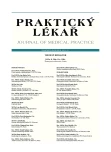Primary prevention of congenital anomalies
Authors:
A. Šípek jr. 1; A. Šípek 2,3,4; V. Gregor 2,3; M. Macek Jr. 5
Authors‘ workplace:
Ústav biologie a lékařské genetiky 1. LF UK a VFN, Praha, Přednostka: doc. MUDr. Milada Kohoutová, CSc.
1; Thomayerova nemocnice, Praha, Oddělení lékařské genetiky, Primář: MUDr. Vladimír Gregor
2; Screeningové centrum Praha – Sanatorium PRONATAL, Odborný vedoucí: doc. MUDr. Tonko Mardešič, CSc.
3; Ústav obecné biologie a genetiky 3. LF UK, Praha, Přednostka: doc. MUDr. Marie Černá, CSc.
4; Ústav biologie a lékařské genetiky 2. LF UK, Praha, Vedoucí: Prof. MUDr. Milan Macek, Jr., DrSc.
5
Published in:
Prakt. Lék. 2012; 92(9): 491-493
Category:
Reviews
Overview
Prevention of congenital anomalies is a very important part of public health policy. Primary prevention comprises a set of actions that have an overarching goal – i.e. to prevent development a congenital anomaly. Primary prevention programs are composed of various recommendations that, if fully complied with, could prevent the majority of congenital anomalies. The implementation of these recommendations into primary care, including other public health programs, is the goal of many professional societies both in the Czech Republic and abroad. Currently, the first set of recommendations is available for clinical practice.
Keywords:
congenital anomalies, primary prevention, prenatal diagnostics
Sources
1. Gregor V., Šípek A., Horáček J. a kol.: Prenatální diagnostika vrozených vad v České republice – aktuální data. Prakt. Lék, 2011, 91(2): s. 85–90.
2. Botto, L.D., Robert-Gnansia, E., Siffel, C. et al.: Fostering international collaboration in birth defects research and prevention: a perspective from the International Clearinghouse for Birth Defects Surveillance and Research. Am J Public Health 2006, 96(5): p. 774–780.
3. Busby, A., Abramsky, L., Dolk, H. et al.: Preventing neural tube defects in Europe: a missed opportunity. Reprod Toxicol, 2005, 20(3), p. 393–402.
4. Kalter, H.: Teratology in the twentieth century. congenital malformations in humans and how their environmental causes were established. Amsterdam: Elsevier, 2003. 166 p.
5. Kučera, J. Populační teratologie. Praha: Avicenum, 1989, 325 s.
6. Šípek, A., Gregor, V., Horáček, J. a kol.: Historie a současnost registrace vrozených vad v České republice. Čas. Lék. čes. 2009, 148, s. 505–509.
7. Greenlees R., Neville A., Addor M.C. et al.: Paper 6: EUROCAT member registries: Organization and activities. Birth Defects Res A Clin Mol Teratol 2011, 91 Suppl 1:S51–S100.
8. Lisi, A., Botto, L.D., Robert-Gnansia, E. et al.: Surveillance of adverse fetal effects of medications (SAFE-Med): findings from the international Clearinghouse of birth defects surveillance and research. Reprod Toxicol 2010, 29(4): p. 433–442.
9. de Walle, H., Abramsky, L. and EUROCAT Folic Acid Working Group.: Special Report: prevention of neural tube defects by periconceptional folic acid supplementation in Europe. EUROCAT Central Registry, 2009, 31 p. [online]. Dostupné na http://www.eurocat-network.eu/content/Special-Report-NTD-3rdEd-Part-I.pdf.
10. Honein, M.A., Paulozzi, L.J., Mathews, T.J. et al.: Impact of folic acid fortification of the US food supply on the occurrence of neural tube defects. JAMA, 2001, 285(23): p. 2981–2986.
11. Nodine, P.M., Hastings-Tolsma, M.: Maternal obesity: improving pregnancy outcomes. MCN Am J Matern Child Nurs 2012, 37(2): p. 110–115.
Labels
General practitioner for children and adolescents General practitioner for adultsArticle was published in
General Practitioner

2012 Issue 9
- Memantine in Dementia Therapy – Current Findings and Possible Future Applications
- Metamizole at a Glance and in Practice – Effective Non-Opioid Analgesic for All Ages
- Memantine Eases Daily Life for Patients and Caregivers
- Metamizole vs. Tramadol in Postoperative Analgesia
- Spasmolytic Effect of Metamizole
Most read in this issue
- Differential diagnosis of genital ulcerations
- Acute bleeding from oesophageal varices
- Psychosocial care of women after perinatal death
- Psychological aspects of stress on medical students
